The Victorian era refers to from 1837 to 1901 in the history of the UK. It started with Queen Victoria’s accession on 20 June 1837. It ended when the Queen died on 22 January 1901. In these 63 years, the British Empire continued to grow over time. During the Victorian era, the British Empire went through enormous changes. They achieved tremendous advancement in the railway, engineering, and trade sectors. The mass production of the sewing machine and synthetic dyes brought significant changes in fashion. This allowed them to mass-produce clothing in less time.
The Victorian era still fascinates a lot of people. This is because of their architecture and fashion. Victorian clothing is still popular with a few people in modern times. Many people are curious about Victorian dress patterns to this day.
Click here if you are looking for a victorian-inspired dress for yourself.
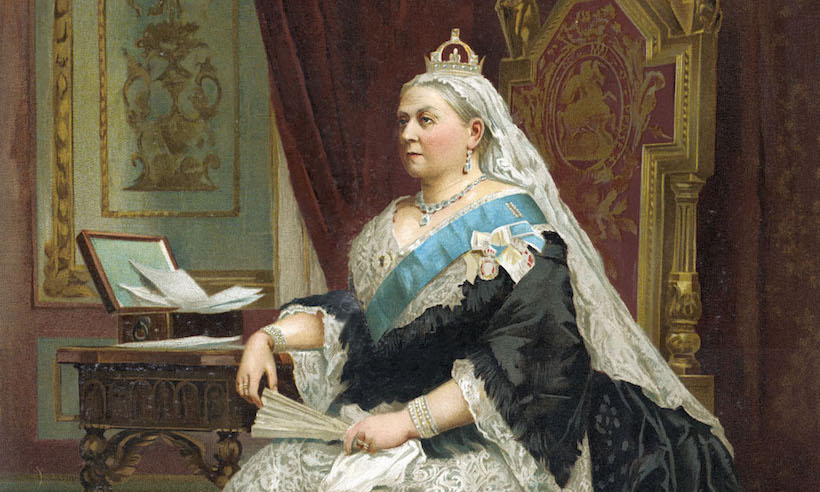
Victorian Women’s Dress
By Victorian Women’s Dress, people mean the dresses worn by upper and middle-class women. At those times, the dresses symbolized wealth. Rich women during that era did not do any housework. It reflected on the design of their dresses.
The dresses were uncomfortable and heavy. It was very hard to move and do any household chores while wearing those clothes. The designs of the dresses focused more on aesthetics than practicality.
The poor working-class women wore much more practical dress. They had to work at home and outside. Their clothing allowed them to work without any hassle.
For some reason, the clothing trends of Victorian rich women are well documented. But it is tough to find enough information about the poor working-class women’s dress. For that reason, much of this article will focus on upper-class Victorian women’s dresses.
Important Parts of Women’s Dress
At first look, most of the Victorian women’s dress looks like a one-piece. But the dresses consisted of many different parts and layers. Most of the dresses had three essential parts. They are a bodice or chemisette, a corset, and a crinoline or bustle with a skirt.
The upper and middle-class women used a tight corset made from lace to wear over the bodice. This was made for the upper body. For the lower body, they wore some sorts of skirts like crinoline or bustle. These skirts had designs of embroideries and had petticoat layers. The Victorian dress pattern changed over the years. But these three things remain more or less similar. The design of these things changed from time to time.
Aside from these four, some women wore engageantes under their sleeves. They are false sleeves made of lace, linen, or lawn.
Here is a detailed description of all these dress parts. This will give some vital information about these parts.
Bodice
The bodice was a favorite upper garment during the 16th to 18th centuries in Europe. A bodice covered the body from the neck to the waist. The neckline varied and changed from time to time. In the Victorian era, the bodice was worn as a part of a two-unit dress. The other part was some sorts of skirts or crinoline. These two parts were connected by hooks and eyes. During the Victorian era, there were two types of bodices. One was a high-necked bodice. Another was a low-necked bodice. This variation allowed women to use the same crinoline for day and evening wear.
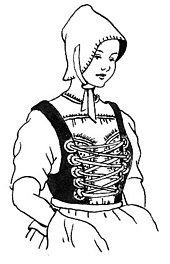
Chemisette
A chemisette is a type of women’s clothing that fills the front and neckline of other garments. During the Victorian era, women wore chemisette under an outer garment. Chemisette has a blouse or shirt-like appearance. It covers the front and neckline without adding extra bulk at the waist or arms. Some women wore linen or cotton chemisette with their dresses. Those chemisettes were decorated with lace, embroidery, and tucks. During the 1850s, some chemisettes had matching engageantes or false sleeves.
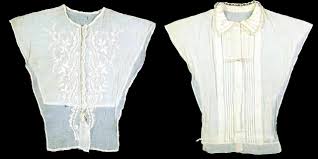
Corset
The rich women used to wear a corset over a bodice or chemisette. A corset served two significant purposes. During the Victorian era, the ideal figure for women was an hourglass figure. That means women strived for a narrow waist and a complete lower body. The corset was made in a way that emphasized the hourglass figure of a woman.
There was another purpose of using a corset. Many women wore a corset to train their waist to be smaller. Wearing a corset for a long period changed the physical appearance of many women’s waist. Many of them were successful in achieving the ideal hourglass figure using a corset.
During the Victorian era, some people blamed the corset for causing a lot of diseases. But this blame did not have any influence over corset’s popularity. The corset was popular during the whole reign of Queen Victoria.
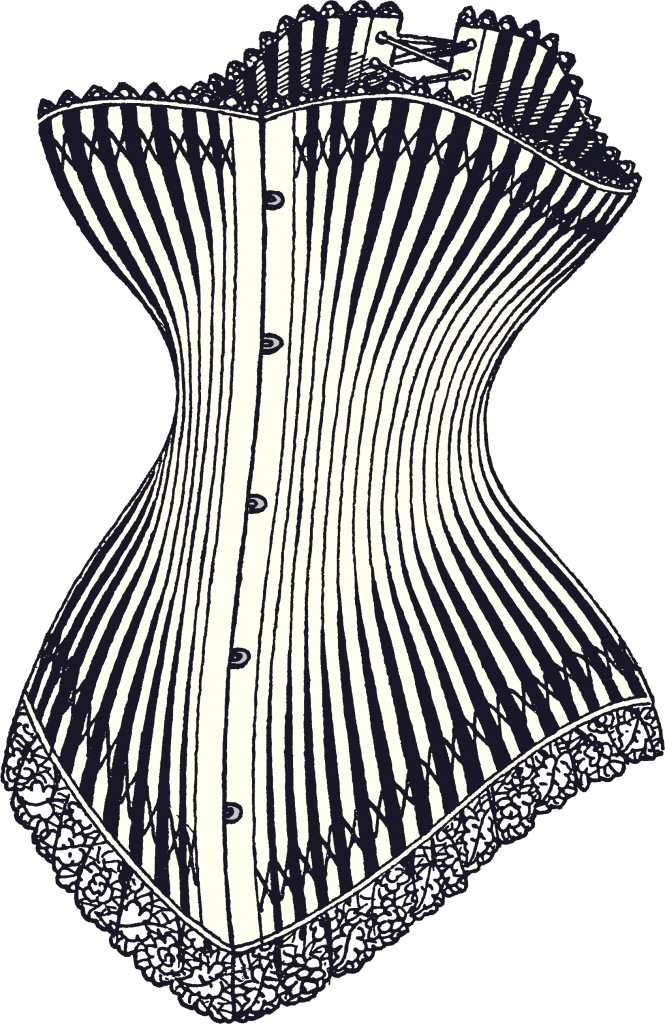
Engageante
Engageantes are false sleeve women used during the Victorian era. These false sleeves were effortless to connect, attach with the bodice. These sleeves were worn under the sleeves. They were made of linen, lace, or lawn. They were very popular with the bell-shaped sleeves of the day dresses.
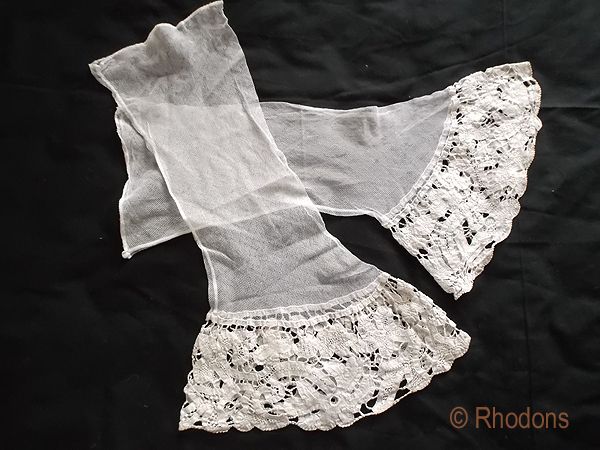
Crinoline
Crinoline was very popular for most of the Victorian era. A crinoline is a structured petticoat. It helps to hold out a woman’s skirt. Crinoline in the early Victorian era was made of cotton, linen, or horsehair. At that time, crinoline had a round bell-like shape. This shape was made from layers upon layers of clothing. The crinoline had at least six layers of petticoats. Some crinoline could weigh around fourteen pounds at that time. This bulky undergarment restricted women’s movement. These types of crinoline lost its popularity at the end of the 1850s. Many women replaced them with more comfortable caged crinoline.
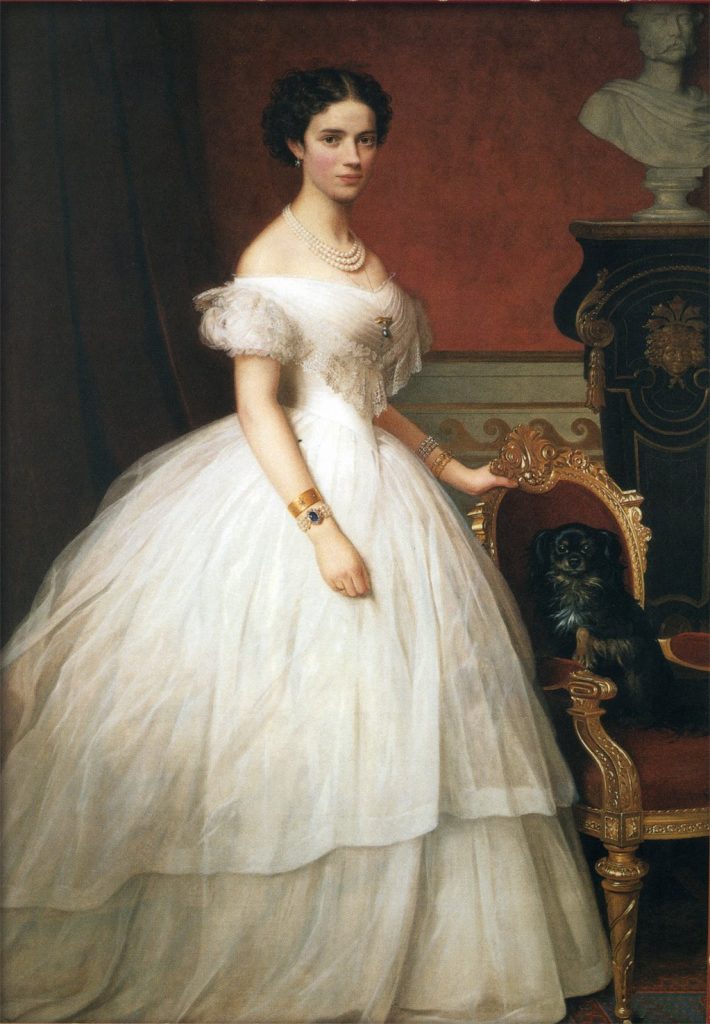
Caged Crinoline
Caged crinoline made their way to the market at the end of the 1850s. They became very popular after they hit the market. At first, this caged crinoline used steel. This design made the crinoline lighter. The open cage allowed women to move their legs freely. Some people used whalebone or rubber to make these caged crinolines. But the steel crinoline remained popular. In the late 1860s, these caged crinolines began to reduce in size. At the beginnings of the 1870s, the crinoline continued to grow smaller. After some time, the bustle replaced the caged crinoline.
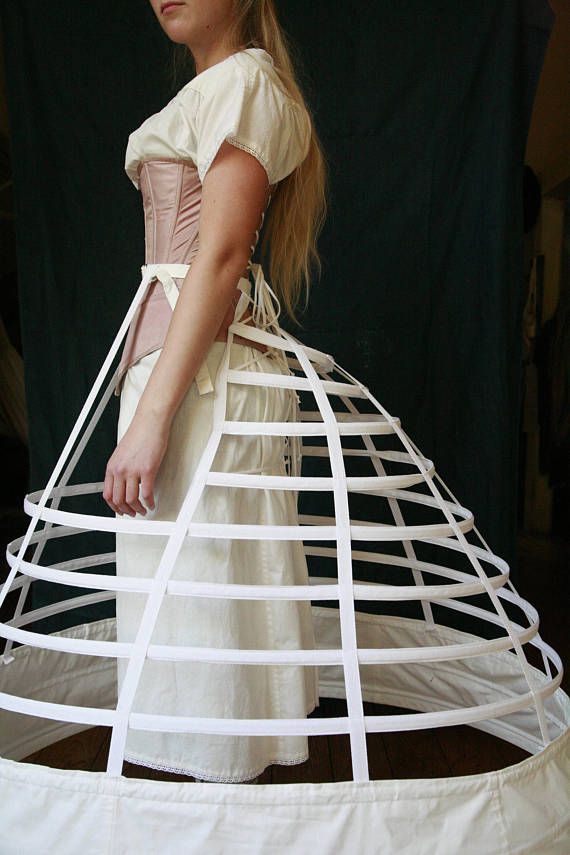
Bustle
The bustle started to become popular in the late 1860s and early 1870s. A bustle is a padded undergarment. It adds fullness or supports the drapery at the back of women’s dress. They were completely different from the bell-shaped crinoline. They were flat in the front and sides. The back was fuller and padded. This created an illusion of an exaggerated rear end. The bustle went through some change during the 1870s and 1880s. After two decades, the bustle started to lose their popularity. By 1890, the crinoline and bustle were entirely out of the market. Women that time wore skirts that flared away from their waist.
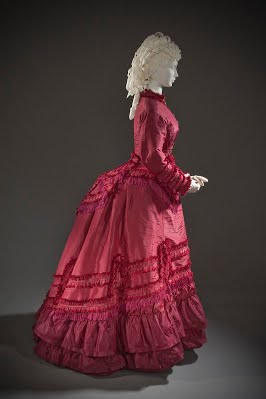
Dress pattern of Victorian women
The pattern of the dresses remained the same. But some components of the dresses went through some changes. In the following paragraphs, we will talk about some design changes in Victorian women’s clothing. We will also talk about the specific dress pattern during every decade.
Changes in dresses over time
The Victorian era lasted over six decades. In that time, fashion and dresses also changed. The women’s dresses, in particular, saw a lot of changes in these periods. Some were major changes. Some were minor changes.
Throughout the era, the upper garment choice remained the same. They were a tight corset over a bodice or chemisette. The design of these items changed over the decades. There are some changes in the neckline, sleeves, and boning of the upper clothing.
The lower half of the clothing saw a considerable change over the decade. All the changes occurred due to the change of silhouette of the undergarment. The results of the silhouette change were crinoline, caged crinoline, and bustle. All of them lost their popularity by the end of the Victorian era.
The changes in neckline, sleeves, boning, and silhouette gave women’s dress a unique look each decade. These changes made a significant impact on women’s dress patterns during the Victorian era.
Neckline
At the beginning of the Victorian era, women wore a low shoulder neckline called Bertha. Bertha exposed the shoulders. Sometimes, these Berthas had a trim with 3 – 6 inches deep flounce. Sometimes, the bodice had a neckline with several horizontal bands of fabric pleats.
These kinds of exposed neckline or bertha were popular with rich women. Only upper-class and middle-class women wore bertha. At that time, poor women did not show much of their skin. So they did not wear bertha.
During the Victorian Era, the design of the neckline changed quite a few times. At first, the neckline was low and straight. Then, women started wearing a V-shaped low neckline. At the end of this era, a high neckline became much more popular.
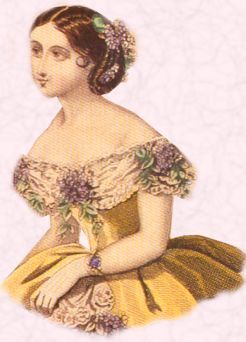
Sleeves
Sleeves went through some changes during this era. There were a few types of sleeves at that time. Most of the time, the sleeves were tight sleeves. It matched with the tight upper body clothing women wore. Over time the shoulder sleeve seam line got lower. It helped to show a tighter fit on the arm. But these types of sleeves limited women’s movement.
There were also some bell-shaped sleeves during the Victorian era. It got popular along with crinoline. These bell-shaped sleeves gave the dress a higher volume. Some women use engageante or false sleeves with these sleeves. These false sleeves were easy to remove or attach with their dresses. Most women used them under the bell-shaped sleeves of their day dresses.
Boning
The boning of the corset remained more or less similar. There were some minor changes to the boning of the corset—the most popular material for boning giant reeds and whalebone. Women used corsets to train their waist. For that reason, the boning of the corset was a little stiff.
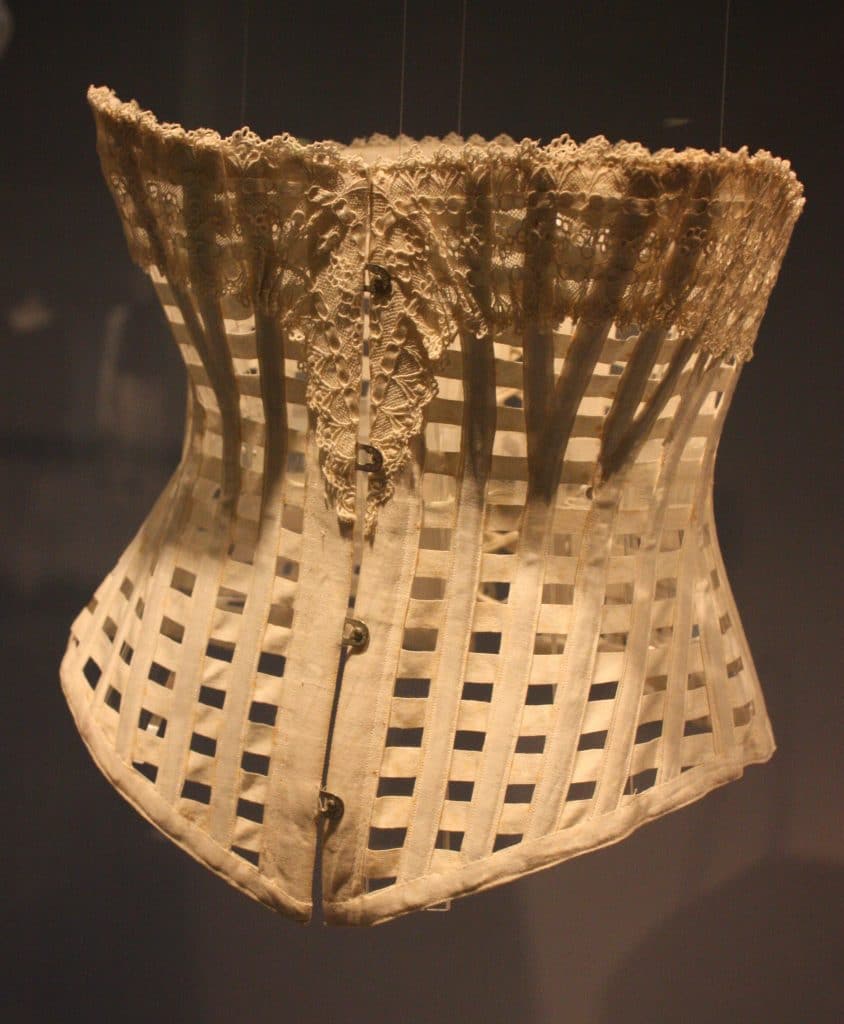
Silhouette
The silhouette of the lower part of the clothing went through some major changes. At the beginning of the era, women wore crinoline. Crinoline had a lot of layers of petticoats. These fabrics of the petticoats were woven from horsehair.
At the end of the 1850s, caged crinoline became popular. The steel structure gave much room to move freely. The caged crinoline also reduced the heavier weight of the regular crinoline.
By the early 1870s, cage crinoline became smaller. After some time, the bustle took their place. Bustle had less volume in the front and sides. The high volume at the rear gave the dress an illusion of an exaggerated rear end.
The last change in silhouette occurred in the late 1890s. Women stopped wearing any type of crinoline and bustle. At that time, the skirt flared away from the waist. This made the waist look tiny.
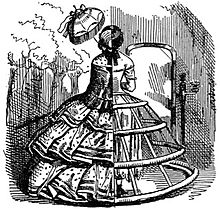
Dress patterns change over the decades
The women’s dress patterns during the Victorian era are well documented. You can find the history of Victorian clothing in this article. We have useful information about how the clothing changes over the decades. Here is a brief description of women’s dresses on each decade.
1830
During this decade, women wore a tight corset over a bodice and a crinoline. This made women’s waist appear smaller. The corset and bell-shaped crinoline helped the women to have an hourglass look. The hourglass figure was the ideal body shape of many women then. The neckline of the bodice straight. Some women wore a low-cut chemise under the corset to avoid exposure.
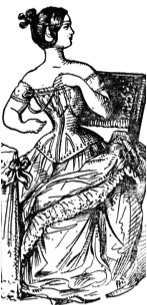
1840
In the 1840s, women’s clothing went through some changes. There were significant changes in necklines, bodices, sleeves, and skirts. The neckline was low. The bodice had an elongated V shape rather than a straight neckline. The sleeves were flaring out from the elbow. For that reason, the sleeves had a funnel shape. The length of the skirt increased. The width increased as well due to the introduction of horsehair crinoline. These horsehair crinolines were a symbol of wealth during that time.
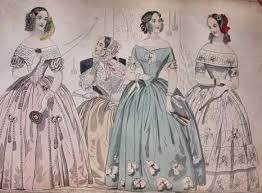
1850
During the 1850s, the neckline of the women’s dress got even lower. The neckline was a low cut, deeper V-shaped neckline. The major change occurred in the design of the crinoline. Though the outer appearance was similar, the crinoline became much lighter. This is due to the introduction of the caged-crinoline. This silhouette of the crinoline got more volume. Also, the invention of the synthetic dye brought some new colors to the clothes.
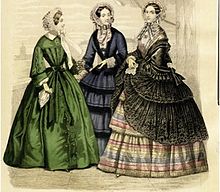
1860
In the 1860s, crinoline started to lose its volume. The top of the crinoline became smaller. The front of the crinoline got flatter. But the rear became much more voluminous. The skirts then featured a train design. During that time, women wore both high and low neckline outfit. The high neckline dresses were for the day. Women wore short neckline dresses in the evening.
At the end of the 1860s, cage crinoline began to disappear. The bustle took the place of caged crinoline.
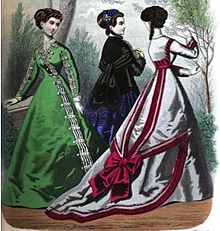
1870
During the 1870s, the dresses went through some more changes. The neckline varied from women to women. The bodice remained at their natural waistline. The silhouette of the skirt became much slimmer. In 1873, polonaise made its way to Victorian fashion. The polonaise had a bodice and an overskirt together. At the end of this decade, many women wore the cuirass bodice. It acted as a corset and extended down to the hips and upper thighs.
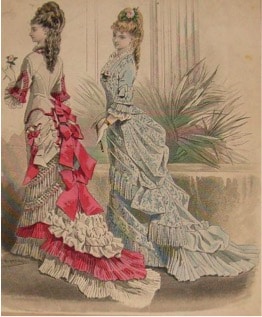
1880
In the 1880s, women’s dresses became more practical. The undergarments were lighter compared to all previous decades. The silhouette of the skirts also followed the natural shape of the body. The corset began to disappear. Women favored practical clothing over stereotypical looks. In 1883, the bustle made a brief appearance. But they went away in 1886. The whole decade went through some stylistic confusion.
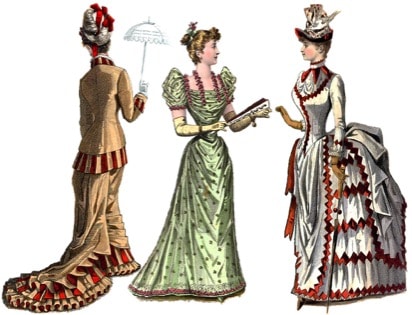
1890
During this decade, the bustle was nowhere to be found. The women wore skirts that flared away from their waist. This skirt was tighter in the hip area. The neckline was high. The sleeves became longer. At the end of this decade, some women started to wear a tailored jacket. Some say that it reflected the standard of early female liberation.
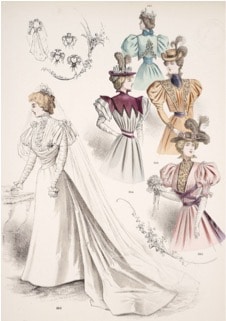
Poor Women’s Clothing
The working-class women had to do work for a living. They did both household chores and worked outside the home. Their dresses were much more practical than upper-class women. Poor women wore a bodice and a skirt. Those clothing did not have extra layers or any embroideries. This made those clothes comfortable during work.
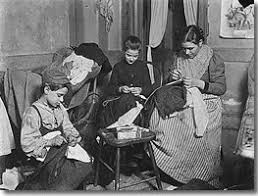
Conclusion
Victorian dress patterns changed a lot during the whole Victorian era. Each decade had gone through some significant and minor changes. Those clothes were well designed. But the dress prioritized aesthetics over practicality. People still admire the design of Victorian women’s clothing. Their popularity transcended the Victorian era and made their ways to the modern days.

